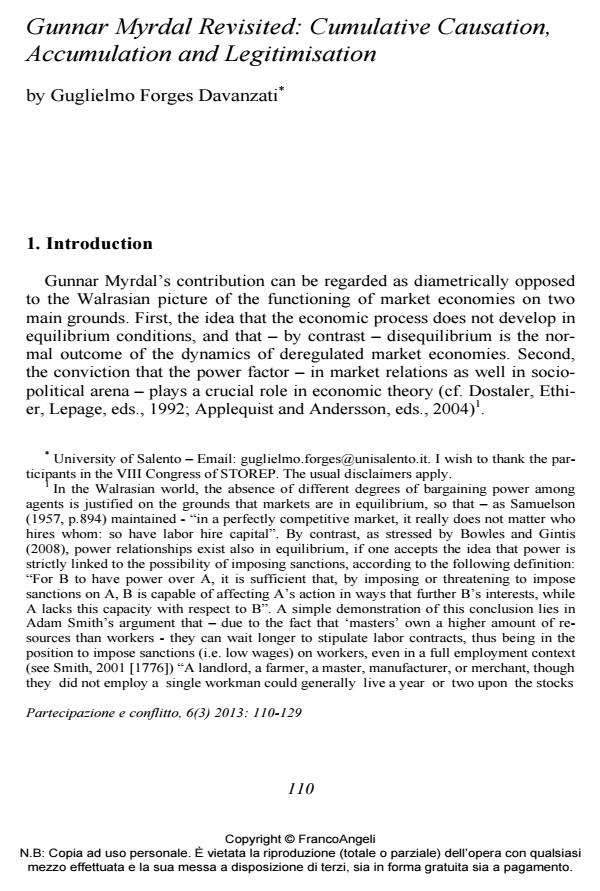Gunnar Myrdal Revisited: Cumulative Causation, Accumulation and Legitimisation
Titolo Rivista PARTECIPAZIONE E CONFLITTO
Autori/Curatori Guglielmo Forges Davanzati
Anno di pubblicazione 2013 Fascicolo 2013/3 Lingua Italiano
Numero pagine 20 P. 110-129 Dimensione file 439 KB
DOI 10.3280/PACO2013-003006
Il DOI è il codice a barre della proprietà intellettuale: per saperne di più
clicca qui
Qui sotto puoi vedere in anteprima la prima pagina di questo articolo.
Se questo articolo ti interessa, lo puoi acquistare (e scaricare in formato pdf) seguendo le facili indicazioni per acquistare il download credit. Acquista Download Credits per scaricare questo Articolo in formato PDF

FrancoAngeli è membro della Publishers International Linking Association, Inc (PILA)associazione indipendente e non profit per facilitare (attraverso i servizi tecnologici implementati da CrossRef.org) l’accesso degli studiosi ai contenuti digitali nelle pubblicazioni professionali e scientifiche
The aim of this paper is to provide a reconstruction of Myrdal’s analysis of the factors determining the path of accumulation, in view of the pivotal role played by political institutions in promoting it. It will be shown that Myrdal’s theory of cumulative causation, combined with his idea that consensus on the existing social order is a "created harmon"”, is a powerful analytical tool in understanding a key contradiction of capitalist reproduction (particularly in a neo-liberal regime): namely the trade-off between accumulation and legitimisation.;
Keywords:Gunnar Myrdal, accumulation, welfare state, political institutions
Jel codes:B25, H11, E25
- Angresano, J. (1997). The Political Economy of Gunnar Myrdal. Elgar.
- Anthon Eff, E. (1998). Myrdal contra Ohlin: Accounting for the sources of U.S. county per capita income convergence using a flexible decomposition approach, “Review of Regional Studies”, 28 (2), pp.91-103.
- Applequist, Ő and Andersson, S. eds. (2004), The essential Gunnar Myrdal. New York: The new Press.
- Bowles, S. and Gintis, H. (1975). The problem with human capital theory – A Marxian critique, “The American Economic Review”, pp.74-82.
- Bowles, S. and Jayadev, A. (2005). Guard labor, Santa Fe Institute, mimeo.
- Bowles, S. and Jayadev, A. (2007). Garrison America, “The Economists’ Voice”: Vol. 4 : Iss. 2,
- Bowles, S. and Gintis, H. (2008). Power, “The New Palgrave Encyclopedia of Economics”. London-New York: McMillan.
- Bunk, S. (2000). Cognition and aging. A rare colony of old macaques gives clues to age impairment, “The Scientist”, vol. 14, n.8.
- Coleman, J.S. (1988). Social capital in the creation of human capital, “The Americal Journal of Sociology”, vol.94, pp.95-120.
- Crotty, J., Epstein, G. and Kelly, P. (1995). Multinational Corporations and Technological Change: Global Stagnation and Unemployment, paper presented for the Economic Policy Institute's Conference on "Globalization and Progressive Economic Policy: What are the Real Constraints? What are the Real Options?", Washington D.C., October 27-29
- Dostaler, G, Ethier, D., Lepage, L.,eds., (1992) Gunnar Myrdal and His Works, Montreal, Harvest House.
- Ferraton, C. (2008). ‘Les valeurs guident et accompagnent notre recherche’: L’institutionnalisme de Myrdal. ENS Paris.
- Forges Davanzati, G. (2006). Ethical codes and income distribution. A study of John Bates Clark and Thorstein Veblen. London: Routledge.
- Forges Davanzati, G. (2011). Credito, produzione, occupazione: Marx e l’istituzionalismo. Rome: Carocci.
- Krugman, P. (1991). Increasing returns and economic geography, “Journal of Political Economy”, vol. 99, n. 3, pp.483-499. Jackson, W.A. (1990). Gunnar Myrdal and America’s conscience. The University of Carolina Press.
- Lucas, L.E. (2007). Unpacking globalization. Lexington Books.
- Malanima P. (2007). Il prodotto delle regioni e il divario Nord-Sud in Italia, (1861-2004), “Rivista di Politica Economica”, III-IV, pp.267-315
- Myrdal, G. (1965 [1939]). Monetary equilibrium. New York: August M.Kelley.
- Myrdal, G. (1939). Fiscal policy in the business cycle, “The American Economic Review”, pp.183-193.
- Myrdal, G. (1944). An American dilemma: the negro problem and modern democracy. New York.
- Myrdal, G. (1957). Economic Theory and Underdeveloped Regions. London: London: General Duckworth & Co.
- Myrdal, G. (1958). Beyond the welfare state. Economic planning in the welfare states and its international implications. London: Methuen.
- Myrdal, G. (1968). Asian Drama: An Inquiry into the Poverty of Nations. New York: Pantheon,
- O’ Connor, J. (2002 [1976]). The fiscal crisis of the State, New Jersey, St. Martin’s Press.
- Panico, C. and Rizza, M.O. (2009). Myrdal, growth process and equilibrium theories, in N.Salvadori, P. Commendatore and M.Tamberi (eds.), Geography, structural change and economic development: Theory and empirics. Cheltenham: Elgar, pp.183-199.
- Palma, J.G. (2009). The revenge of the market on the rentiers. Why neo-liberal reports of the end of history to be premature, “Cambridge Journal of Economics”, 33, pp.829-869.
- Piven, F. and Cloward, R. (1998). Eras of power, “Monthly Review”, vol.49, n.8.
- Rutherford, M. (1994). Institutional economics at Columbia University, “History of Political Economy”, 36 (spring), pp.31-78.
- Sai-wing Ho, P. (2004), Myrdal's backwash and spread effects in classical economics: implications for multilateral trade negotiations, “Journal of Economic Issues”, June.
- Sai-wing Ho,P. (2008). Arguing for policy space to promote development: Prebish, Myrdal, and Singer, “Journal of Economic Issues”, June.
- Samuelson, P. (1957).Wages and interest: A modern dissection of Marxian economics, “American Economic Review”, pp. 884-921.
- Smith, A. (1976 [1776]). An inquiry into the nature and the causes of the wealth of the nations. London: Oxford University Press.
- Stiglitz, J.E. (2002). Globalization and its discontent. New York: W.W.Norton.
- SVIMEZ (2011). Rapporto annuale sull’economia del Mezzogiorno. Rome.
- Tobon, A. (2006). On prices in Myrdal’s monetary theory, “History of Economics Review”, winter.
- Thurow, L. (1970). Investment in human capital. Balmont: Wedsworth Pub. Co.
- Perspectives and Trends in Education and Technology Cândido Gomes, Cristina Costa-Lobo, Dulce Noronha-Sousa, Enrique Vázquez-Justo, Eusebio Costa, Susana Sá, pp.945 (ISBN:978-981-16-5062-8)
Guglielmo Forges Davanzati, Gunnar Myrdal Revisited: Cumulative Causation, Accumulation and Legitimisation in "PARTECIPAZIONE E CONFLITTO" 3/2013, pp 110-129, DOI: 10.3280/PACO2013-003006